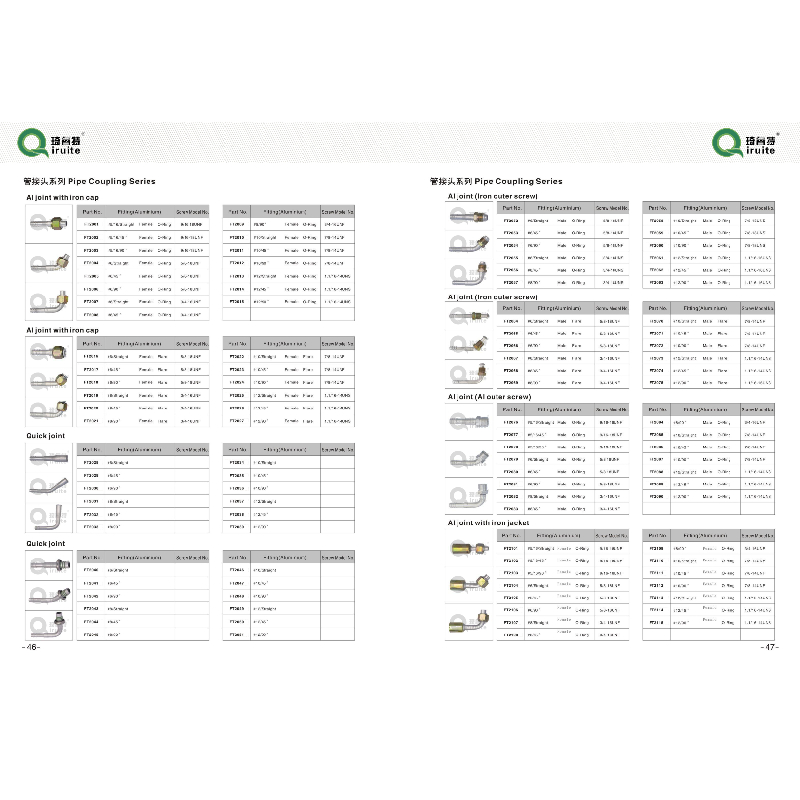Quick Release Ball Joint | Tool-Free, Secure, Durable
Field Notes on the Quick Release Ball Joint Pipe Coupling Type
I spent a day in Ningjin County, Hebei Province, walking the shop floor where these aluminum couplings take shape. It’s not flashy—machines hum, operators check gauges, someone jokes about the weather—but the output matters: compact, leak-tight connectors that save techs minutes per joint. And minutes add up.

Why this matters now
Two industry threads keep crossing: faster serviceability and cleaner assembly lines. The Quick Release Ball Joint form factor—paired here with O-ring face seals and UNF threads—lets HVAC and low-pressure hydraulic teams cut downtime without compromising reliability. To be honest, a lot of engineering managers quietly judge components by how quickly their crews can rework them on a bad day.
Product snapshot: Pipe Coupling Type (Aluminium)
Origin: Ningjin County, Hebei Province. Real-world users tell me these are “surprisingly forgiving” during maintenance, especially around tight bends.
| Part No. | Form | Connection | Thread | Material | O‑Ring |
|---|---|---|---|---|---|
| FT2001 | #5/16 Straight Female | O‑Ring Face Seal | 9/16‑18 UNF | Aluminium (≈6061‑T6) | NBR or FKM (app‑dependent) |
| FT2002 | #5/16 45° Female | O‑Ring Face Seal | 9/16‑18 UNF | Aluminium (≈6061‑T6) | NBR or FKM |
| FT2003 | #5/16 90° Female | O‑Ring Face Seal | 9/16‑18 UNF | Aluminium (≈6061‑T6) | NBR or FKM |
How they’re built (short version)
- Materials: Aluminium billet, anodized; optional hard-coat for abrasion.
- Methods: CNC turning/milling, ball-track forming, deburr + ultrasonic clean.
- Sealing: O‑ring groove per ORFS practice; compatibility with PAG/POE oils noted.
- Testing: Helium leak ≤1×10⁻³ mbar·L/s; hydrostatic burst ≥4× WP; salt spray per ISO 9227.
- Service life: ≥10,000 mate/demate cycles (lab); real-world use may vary.
- Certs: Manufacturer cites ISO 9001; automotive programs often ask IATF 16949.
Where they show up
Automotive A/C lines, light-duty hydraulics, chillers, skid units, and test benches. The Quick Release Ball Joint geometry simplifies access around compressors and manifolds; techs like the 45° and 90° variants when space is, well, unfriendly.
Performance notes and data
Typical working pressure: around 1.5–3.5 MPa (220–500 psi) depending on media and temp; burst >4× WP in validation. Leak class matched to ISO 19879 test profiles; several customers report “no top-ups for a season” on HVAC skids—anecdotal but consistent.
Vendor comparison (indicative)
| Vendor | MOQ | Lead Time | Certifications | Customization | Price |
|---|---|---|---|---|---|
| HoseQRT (Hebei) | 500 pcs | 2–4 wks | ISO 9001; RoHS/REACH | Angles, O‑ring, anodize color | $ (value) |
| Vendor A | 1,000 pcs | 4–6 wks | IATF 16949 | Limited | $$ |
| Vendor B | 200 pcs | 1–2 wks | ISO 9001 | Threads, knurl, logo | $$$ |
Customization tips
If your media runs hot or includes mild acids, ask for FKM seals and hard‑coat anodizing. For quick assembly, specify laser-etched part codes. And if vibration’s nasty, a Quick Release Ball Joint with a slightly deeper O‑ring groove (within spec) tames micro-movement.
Mini case study
A chiller OEM swapped legacy brazed joints for FT2002/FT2003. Result: assembly time down ≈18%, leak calls down 23% over two quarters. One tech told me, “the 90° saves my knuckles.” Not scientific, but it tracks.
Standards to align with
Designers typically reference ISO 19879 (test), ISO 9227 (corrosion), and SAE J514 thread/flared fitting conventions for interface sanity. Always validate with your fluid, temp, and cycle profile.
References
- ISO 19879: Metallic tube connections — Test methods for hydraulic fluid power.
- ISO 9227: Corrosion tests in artificial atmospheres — Salt spray tests.
- SAE J514: Hydraulic Tube Fittings (UN/UNF threads and sealing styles).
-
Quick Release Ball Joint – Tool-Free, Durable, Leak-TightNewsNov.13,2025
-
Spiral Guard Hose Protection — Durable, UV-Resistant WrapNewsNov.13,2025
-
SAE J1401 Brake Hose Specifications: Durable, Low ExpansionNewsNov.13,2025
-
SAE J1401 Brake Hose Specifications | DOT-Approved, DurableNewsNov.13,2025
-
Spiral Guard Hose Protection - Abrasion-Resistant, UV-StableNewsNov.10,2025
-
SAE J1401 Brake Hose Specifications | DOT-Certified, DurableNewsNov.10,2025

